Musical instrument: Duduk
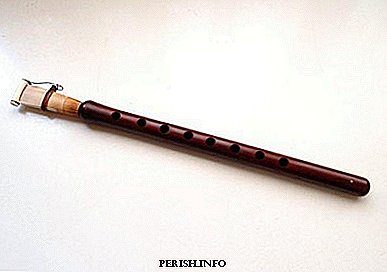
Armenia is an amazing ancient country. Who was lucky enough to visit there at least once, impressions and pleasant memories will remain for life. Armenia is famous for the extraordinary beauty of landscape nature with the mountain peaks of Ararat, kind people, national cuisine, the most delicious apricots in the world and interesting traditions. But there is one more attraction, to which the Armenian people treat with special trepidation, its pride - an ethnic musical instrument - duduk. It is called the tool with the soul of the apricot tree. The cultural life of Armenia and the duduk are inseparable from each other, it reflects the social identity inherent in the colorful and diverse Armenian people. Armenians claim that the duduk expresses all the spiritual subtleties and experiences, the pain of their hearts. All important events in the life of the people: weddings, funerals, various celebrations and public holidays are accompanied by a prayer-like sound of this unique instrument.
The history of the duduk and a lot of interesting facts about this musical instrument, read on our page.
Sound
Listening to the duduk, it is impossible to remain indifferent to its soft and warm, like a human voice, velvety expressive sound. The timbre of the instrument, which is distinguished by lyrical emotionality, is capable of conveying subtle emotional experiences and shades of human grief.
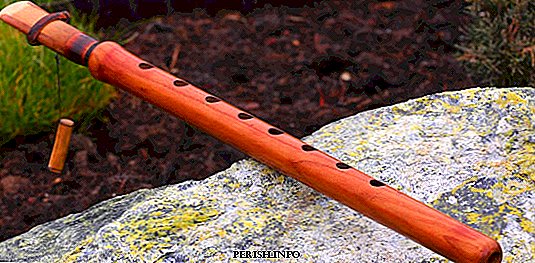
For a more colorful performance of music on the duduk, a pair performance by two musicians is characteristic: one performs the main theme, and the other, which is called Dam or Damkash, creates a continuous background sound. It is in this performance that the music brings a feeling of tranquility, high spirituality and makes it possible to feel the breath of time.
A very small range of duduk is slightly more than an octave. With the diatonic structure of the instrument, but if the sound holes on it are not completely blocked, extraction of chromatic sounds is permissible. Therefore, it is possible to play music written in different keys on a duduk.
The sound of the duduk appears as a result of vibrating the reed tongue and the oscillation in the instrument of the air jet, creating the performer.
A photo:

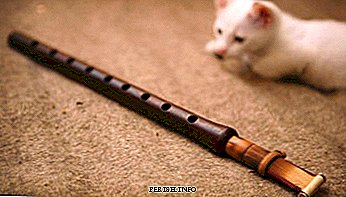


Interesting Facts
- The duduk today has three names: tsiranapokh (translated from Armenian as "apricot tube" or "soul of an apricot tree"), duduk (the name passed from the Turks a little more than 100 years ago) and the Armenian clarinet.
- Many nations have tools in their structure resembling a duduk. Macedonian, Serbian, Bulgarian, Croatian forged; Georgian duduks; Dagestan, Azerbaijani, Iranian balaban; Chinese Guan; Japanese Hichiriki; korean piri; Russian, Ukrainian and Belarusian pipe; Moldovan, Romanian, Uzbek, Tajik nay; Turkish Mei is just a small list of tools that are similar in design to the duduk.
- Dudukist - the so-called duduk musician.
- The craftsmen who made the duduk, in order to achieve a beautiful sound, experimented a lot with the material, using different varieties of trees and even crystal.
- In Armenia, the duduk is made of apricot trees that grow in this country, and according to the conviction of its inhabitants, they symbolize strength of mind and true long love.
- Outstanding Armenian composer A. Khachaturian he said that only a duduk from instruments could make him cry.
- In Armenia, the duduk is a very famous and favorite instrument, and the performers on it are very respected and revered. However, this was not always the case. In the past, dudukists were considered frivolous and untenable people, contemptuously calling them “zurnachami.” The families even refused to match their daughters.
- Warpet - this word in Armenia means not just a great master, but a creator. Armenians still call Vache Hovsepyan the great warpet and king of duduk.
- In Armenia, there is a unique ensemble in which performers play only on Armenian duduks. This musical group has the appropriate name - "Dudukner". The total range of the ensemble, which consists of three octaves, allows you to play music of various musical directions, from classical to jazz.
- Hollywood filmmakers are very interested in the lively voice of the duduk, including its sound in the musical accompaniment of their films. "Gladiator", "Last Temptation of Christ", "Munich", "Passion of the Christ", "Da Vinci Code", "Ash and Snow", "Onegin", "Siriana", "Crow", "Alexander", "Hulk" , "Xena is the warrior queen", "Ararat", "Game of Thrones" is just a small list of 60 famous movies, whose soundtracks are decorated with the sound of a duduk.
- In 2005, the UNESCO International Organization recognized the music played on the Armenian duduk to be a masterpiece of the intangible cultural heritage of mankind.
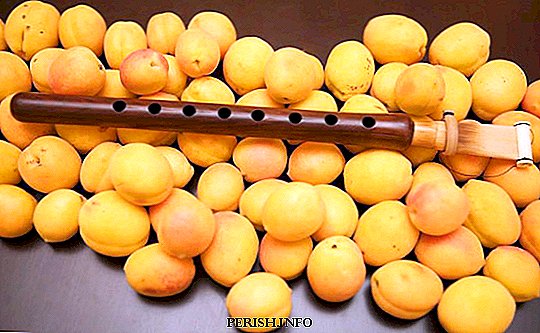
- In February 2015, according to the original idea of production director A.Titel in the Musical Theater named after Stanislavsky and Nemirovich-Danchenko at the premiere of the opera "Khovanshchina"For the first time in the ensemble of Armenian folk instruments, the duduk sounded in the Russian opera.
- In Moscow in 2006, a monument to the Armenian duduk was erected in Shemilovsky Lane. The monument, symbolizing the continuity of generations and loyalty to national traditions, is called "Song of the Motherland".
Design
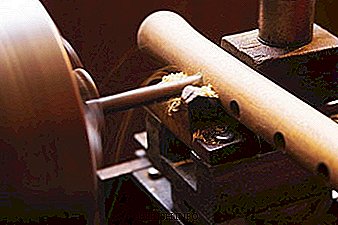
The duduk, being the reed woodwind of instruments, during its long history has hardly changed its external form. Its very simple device includes a tube and a cane, which is a double tongue.
- On a tube that has a cylindrical shape, the length of which varies from 28 to 40 cm (28, 33, 40), there are sound holes: 7, sometimes 8, on the front and 1 or 2 on the reverse side. A special type of apricot tree, which grows only in Armenia, is traditionally used as a material for the manufacture of the tube. It is believed that it is his wood that has special resonating properties that give the sound of the instrument such a spiritual and emotional sound.
- A cane, the length of which is from 9 to 14 cm, usually has a cap, and it is also equipped with a tone control, which makes it possible to adjust the sound of the instrument.
Varieties
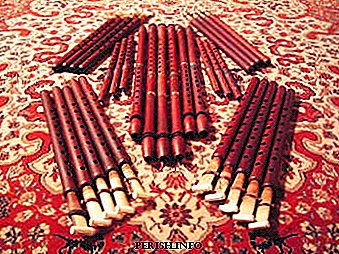
The duduk family can be divided into solo and ensemble instruments. Soloers differ in size and structure.
- Duduk in the system G. Range - mi small octave - For the first octave Length - 38 cm. It has the lowest sound. The tone is velvety, but piercing.
- Duduk in building A. Range - F-sharp of the small octave - C of the first octave. Length - 36 cm. The most common tool.
- Duduk in building B. The range - salt of a small octave - to the first octave. Length - 34 cm. Also very common.
- Duduk in the structure of H. The range is the G-sharp of the small octave - the C sharp of the second octave. Length - 33 cm. The color of the sound is bright and bright. It is used in the performance of dance tunes.
- Duduk in building C. Range - for a small octave - re of the second octave. Length - 30 cm. It sounds bright, high and piercing. Used in ensembles as a solo and accompanying instrument.
- Duduk in system D. Range - B-flat small octave - the re-sharp of the second octave. Length - 29 cm. The sound is bright and clear. It is often used as a solo and accompanying instrument.
The ensemble instruments include the tenor duduk, the baritone duduk and the bass duduk. They were designed relatively recently to create a unique ensemble that consists of instruments of this type only.
Application
Throughout its long history, the duduk has become an integral part of the culture of Armenia. All vital events of the inhabitants of the country are accompanied by the sound of this unique instrument. His quiet philosophical crying accompanies man to the “last journey”. He sings emotionally at various parties: weddings, birthdays, state celebrations. In addition, attracting the sound of performers in various modern musical genres, to date, the range of its application is very extensive. In addition to participating in folk ensembles, the voice of the duduk very often decorates soundtracks for various films with its timbre color, as well as compositions in such musical directions as jazz, rock, blues, pop music, rock'n'roll and classical music.
The repertoire for the duduk is very limited due to the small range and is mainly based on Armenian folk music. Recently, with the advent of new varieties of instruments such as the tenor duduk, the baritone duduk and the bass duduk, the range of its sound has expanded considerably. In the ensemble performance on these instruments, it became possible to hear the works of classical music by I.S. Bach, V.A. Mozart, S. Rakhmaninov, D. Gershvin, as well as Armenian composers A. Khachaturian, A. Spendiarov, Komitas, G. Narekatsi, N. Shnorhali, M. Ekmalyan.
Performers
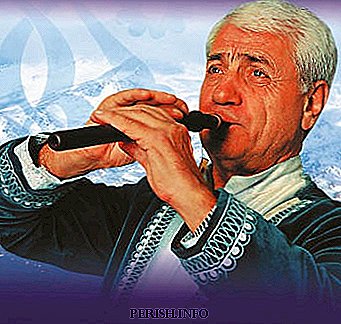
In Armenia, they believe that only musicians who have Armenian roots in the genus can play a truly beautiful duduk, since this is genetically laid for them.
One of the greatest dudukists of the 20th century, which no one could surpass in the virtuosity of playing an instrument, is still considered Vache Hovsepyan.
At the present time, Jivan Gasparyan is an outstanding performer who is well known throughout the world and has done much to popularize the instrument and its international recognition. His concerts, held in the best concert halls, are scheduled for many months in advance.
Of particular note is the contribution to the development of the instrument of a gifted performing musician, teacher Georgy Minasov. Having expanded the range and performance capabilities of the instrument, he created a unique ensemble of dudukists.
Among the talented performers who presently adequately represent the duduk at concert scenes and delight listeners with the sound of a unique instrument, I would like to mention O. Kasian, G. Malkhasyan, L. Garibyan, S. Karapetyan, G. Dabagyan, A. Martirosyan, K. Seyranyan , O. Ghazaryan, N. Barseghyan, R. Mkrtchyan, A. Avedikyan, Argishti.
From time immemorial, the duduk in Armenia was considered an exclusively masculine tool. However, the winner of the All-Union Music Festival, Armine Simonyan, became the first duduk woman to break this stereotype.
Story
When the duduk appeared and who first cut the instrument from the apricot tree, now nobody can say for sure. But the fact that it exists from ancient times, no one argues. Even in the ancient manuscripts of the state of Urartu, which existed in the third millennium BC, in the territory which now partly belongs to Armenia, historians found information about the instrument extremely similar to the duduk. Then the tool is again indirectly mentioned in the ancient sources of the first millennium before Christ, the time of the reign of Tigran the Great. And only the Armenian historian Movses Khorenatsi, who lived in the 5th century AD, gives more reliable information about the instrument, calling it “tsinarapoha”, that is, an apricot tube.
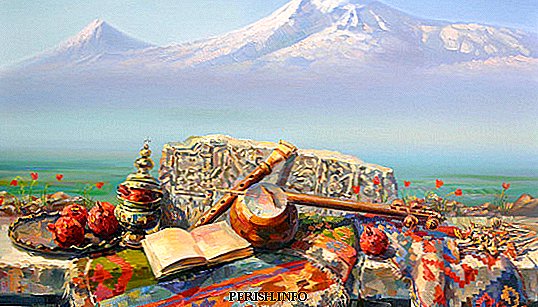
But thanks to the images that have come down to us in the ancient manuscripts of the Middle Ages, we learn that the duduk was a very popular tool not only in Armenia, but also in the countries of the Middle East, in the Crimea and in the Balkans.
Over the years of its long existence, the duduk has not actually changed, but in ancient times in Armenia there exists a belief that the instrument will sound only if it is made by the musician himself, so that the performer’s duduk and soul can merge into one whole. Nowadays, no one sticks to this tradition, and craftsmen who know the secret secrets of this fine business are engaged in the manufacture of tools.
One of the initiators of the improvement of the duduk, which has remained unchanged for millennia, is the enthusiast and gifted performing musician George Minasov. Together with the talented master of musical instruments Sergey Avanesov, they created a set of instruments: a tenor duduk, a baritone duduk and a bass duduk. The total range of instruments now began to be three octaves and allowed the performers to significantly expand the repertoire.
The duduk is an ancient instrument, always respected and loved. Performing art is flourishing and attracting an increasing number of musicians and music lovers. The duduk with its passionate and deep voice reaches every heart regardless of nationality and religion, thereby conquering cities and countries.

Leave Your Comment